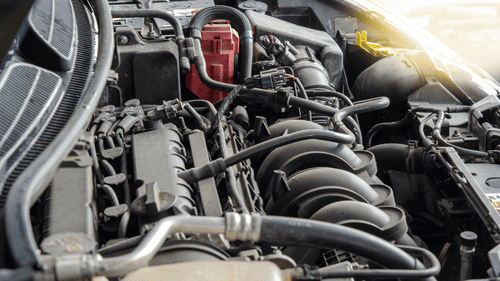What are Some Basic Car Maintenance Tips?
You do not have to be a car expert or an enthusiast to care about your car! You can easily create a car maintenance schedule to keep track of all the maintenance your car will need throughout the year. Check your car owner’s manual to see what the manufacturer recommends for routine car maintenance. The manual will usually have a set maintenance schedule that includes recommended services / intervals. Once you have a set schedule, you can stay on top of routine car maintenance throughout the year.
In addition to keeping your vehicle safe and reliable, proper car maintenance can help you maintain the car's current condition. If you choose to sell your car in the future, you could ask for a higher price if it’s in good condition! If you can maintain your vehicle correctly, you can potentially avoid the hassle of paying for expensive repairs in the future.
LoanMart has compiled some of the handiest car maintenance tips to help you maintain your vehicle’s current condition and prolong the life of your car! Keep reading to learn more.
- Replace Your Cabin Air Filter: The cabin air filter in your car is responsible for eliminating pollutants and filtering the air that enters through your HVAC system. You can usually find it behind the glove box, under the dashboard, or in the engine compartment near the base of the windshield. The cabin air filter is essential for maintaining the air quality in your vehicle since it removes debris, pollen, pollution, and other particulates. You could easily replace your cabin air filter at home by checking your owner’s manual for instructions.
- Change Windshield Wipers: Generally, you should replace your windshield wipers every 6 to 12 months or whenever the wipers are compromised. However, individuals who live in a cold climate may need to replace their windshield wipers more frequently. You can replace your windshield wipers yourself - there’s no need to visit a mechanic. Also, check your windshield wiper fluid regularly.
- Check Your Spare Tire: Check your spare tire once a month to ensure that it has the proper amount of tire pressure. Your tire should not have any signs of tire aging, damage, or excessive treadwear. During your tire inspection, if you see any of those signs, it may be time to buy a new spare tire. If you have a flat tire on the side of the road, you do not want to discover that your spare tire is flat or damaged! Otherwise, you may need to call a tow truck to come and save you. Some cars do not come with a spare tire, but they may come with a patch kit that you can use if you damage your tire while driving.
- Change the Oil: One of the most important car maintenance tips is about the engine oil in your car. If you regularly change your engine oil, you can prolong your car engine’s life and potentially avoid some major mechanical problems in the future. Typically, you will need to change your oil every six months or every 5,000-10,000 miles, depending on:
- Your Driving Habits
- The Age of Your Car
- The Quality of the Oil You Use in Your Car
If you have a newer car that takes blended or full synthetic oil, you may be able to stretch it to 10,000 miles in between oil changes. The best way to learn more about your vehicle and oil changes is to consult your regular mechanic or check your owner’s manual. Do not skip an oil change!
- Check Your Brakes Regularly: Generally, you should check your brake pads every six months. But, the amount of wear and tear on your brake pads will depend on a few different factors, such as:
- Your Driving Habits
- The Size and Weight of Your Car
If you drive in the city every day and slam on the breaks often, you may experience more wear and tear than a driver who only drives on country roads. If you hear any squeaking or squealing when you press on the brakes, it is time to replace your brake pads. Make sure to take it easy on your brakes and get them replaced as soon as they start squeaking, so you do not damage your rotors. It can be expensive to repair or replace your rotors.
Although these are not the only tips that can help you maintain the current condition of your car, they can still be helpful in the long run. The owner’s manual of your car can also help you keep track of routine maintenance and establish a schedule.
Routine maintenance is usually not that expensive, but if you do need emergency cash to repair your engine, change your brake pads, or replace your tires, you could apply for a title loan serviced by LoanMart! Title loans, otherwise known as auto title loans or car title loans, can allow you to pledge the title of your vehicle as collateral for the loan. If you are approved, you could get your money in as little as one business day.¹ ³ Visit the website or call a title loan agent today at 855-422-7412 to begin the application process! Keep reading to get more car maintenance tips from LoanMart.
What are 7 Car Maintenance Tips That Can Help You Save Money?

Call Our Team
Take the first step and call our toll-free hotline to speak with a specialist.
Looking to save money and maintain your car’s current condition? Take a look at these seven vehicle maintenance tips that can help your car and your budget:
- Control Your Lead Foot: If you drive with a lead foot, not only are you at risk of speeding tickets, but it can waste a lot of gas! Speeding tickets can be expensive, and if you have a lot of speeding tickets on your driving record, that could potentially affect your insurance rates. Additionally, consistent acceleration could potentially damage your car’s engine. It can cost thousands of dollars to replace or repair your engine, so keep that in mind the next time you decide to stomp on the gas pedal!
- Keep Up With Routine Maintenance: While it can be a hassle to keep up with routine maintenance, it is extremely important! Don’t skip your routine oil changes and tire rotations - you may save a few dollars temporarily, but it can cost you a lot of money in the long run. Preventive maintenance can potentially help you avoid a larger and more expensive mechanical issue in the future. Whether you need extra money to pay for an oil change or an expensive repair, consider a title loan serviced by LoanMart! You could access up to 50% of your car’s total value if you are eligible for a car title loan.¹
- Get a Mechanic You Trust: It’s important to shop around and find a mechanic or a reputable service center you trust. A reputable shop will be honest and charge fair prices. A number of mechanics and service centers have earned a bad reputation due to their habit of overcharging customers for routine maintenance or being dishonest during routine service check-ups. Car maintenance and repairs shouldn’t be a sketchy business! Many trusted mechanics in the industry get a lot of business from word of mouth - so ask a family member or an acquaintance you trust if they have a mechanic they would recommend. Once you find a trustworthy mechanic, you could potentially save plenty of money. You won’t be wasting your money on unnecessary or fraudulent repairs! Shop around and find the right mechanic for your vehicle and current budget!
- Care for Your Vehicle in the Winter: If you live in an area that experiences regular snowfall in the winter, you must ensure that you protect your car from the elements as much as you can. Not only can the snow sometimes be annoying, but it could also damage your vehicle if you’re not careful. For example, if you drive around in the winter and a lot of snow accumulates on the hood or the sides of your vehicle, the salt and chemicals from the road can mix with the snow, which can corrode your vehicle's paint. The salt from the snowy roads can also build up rust on exposed parts of your vehicle and cause a lot of damage. Make sure to wash your car often to keep the salt and snow under control. Additionally, you should wipe the snow off your car as often as possible. During the winter months, you should also make sure that the tires on your car have the proper amount of tire pressure. Your car should have at least a quarter tank of gas at all times. If you take care of your car during the winter months, you can avoid expensive repairs in the spring!
- Watch Mechanics on YouTube: One of the most significant advantages of YouTube is that you can find a video for almost any situation. When it comes to car maintenance tips and repairs, you can easily find a video that was uploaded by a reliable mechanic! You can find a lot of videos on car maintenance, changing tires, and replacing windshield wipers.
The Humble Mechanic, ChrisFix, and Mighty Car Mods are some of the most popular and valuable YouTubers who can show you how to properly care for your car - without visiting a shop or a mechanic. There are so many different channels on the platform to watch if you want to learn more about car maintenance and how to save money. - Buy Your Own Parts: It is important to understand that when you bring your car into the shop for car repairs, you are typically paying for two different things:
- The Part(s) Required to Fix Your Car
- The Amount of Labor Required to Repair Your Vehicle
If you bring your car into a shop, the mechanic will be able to tell you what part(s) you will need to fix your car - but you do not have to do the labor yourself. You may be able to purchase parts at an auto parts store or salvage them from a junkyard. By purchasing the parts yourself, you will have the opportunity to shop around and potentially find the best price.
- Protect Your Car Seats with Covers: The interior of your car can go through a lot of wear and tear as you use it over time. However, you can protect your vehicle's interior surfaces by putting on car seat covers! If you have kids, you can get a special seat cover for the backseat that can accommodate their car seats. You can get covers that match your car's existing interior, or you can get creative and choose a funky design. It’s important to protect your car’s interior from any potential damage, such as sun damage. If you have leather seats, they can easily crack or fade if they are exposed to a lot of sunlight over the years. You could potentially increase your car’s value by doing something as small as installing seat covers!
How Can I Improve My Car’s Engine Life?

If you want to keep your car for a long time and improve your car’s engine life, you will need to do preventative maintenance. But, here are some tips to improve your car’s engine life that are often overlooked by a lot of car owners:
- Get Your Oil Changed Regularly by a Professional
- Check Your Owner’s Manual and Follow the Recommended Maintenance Schedule
- Limit Abrupt Acceleration
- Don’t Overload Your Vehicle with Excessive and Heavy Items
What are Some Ways to Save Money on Gas?
Gas prices change daily, so it can be challenging to find a gas station that can offer cheap gas.
Check out some tips you can use to save the most money on fuel:
- Drive at a Steady Pace to Save Gas
- Proper Vehicle Maintenance
- Monitor Your Tire Pressure
- Decrease Your Traveling Weight
- Don’t Let Your Car Idle for Too Long
- Use Your HVAC System Sparingly
If you follow these tips, you could save some money and use it for other expenses that require your attention. However, if you don’t have the funds to cover some of your bills this month, you could apply for an auto title loan serviced by LoanMart! Call 855-422-7412 for more information about car title loans.
Can a Title Loan Help You Pay for Car Maintenance?

It’s essential to perform regular check-ups on your vehicle and stay up to date with your maintenance schedule in order to keep your car in good condition. However, none of that matters if you don’t have the money upfront to cover the maintenance costs.
Thankfully, car title loans serviced by LoanMart could be a solution to consider if you find yourself in that situation!
Get started on your loan inquiry today by filling out a brief pre-approval form online or calling a title loan agent at 855-422-7412.¹ ³
Frequently Asked Questions:
What Car Parts Need the Most Maintenance?
While it’s important to take care of every aspect of your vehicle, there are a few parts of your car that may require more regular maintenance than others:
- Battery
- Tires
- Engine
- Brake Pads
What are 3 Good Car Maintenance Habits?
The 3 most important car maintenance habits are simple and straightforward:
- Change Your Engine Oil Regularly
- Make Sure to Inspect the Car for Any Signs of Wear and Tear
- Follow the Vehicle Maintenance Schedule in Your Owner’s Manual
What are the Hardest Things to Fix in a Car?
While the answer depends on who you ask, generally, the three hardest things to fix in a car are:
- The Engine
- The Suspension
- The Transmission
What Keeps a Car Engine Healthy?
There are two things that can potentially keep a car engine healthy:
- A Constant Flow of Air in the Engine
- Changing the Engine Oil Regularly
What is the Most Important Routine Car Maintenance?
Your engine oil should be changed by a professional on a regular basis. This is the most important part of routine car maintenance, and it will prolong the life of your engine.

